A couple interested in sustainability purchased this 1926 foreclosure home slated for demolition by most prospective buyers. Instead of demolishing, defiantly, the clients decided to add. Foundations, floors, walls, and roof were salvaged and structurally restored to current hurricane codes; saving approximately 260 cubic yards of construction debris from landfills. Given the fact that the house had been extensively remodeled at different time periods, the exterior no longer retained its original character. Therefore the outside portion of the project became an exercise in modern design, combining two main rectilinear volumes with a redwood-clad entry trellis. Inside, the historic character of the house’s original 1920’s Dade-county pine wood floors, shaker style moldings, and curved ceiling cornices contrasts with the contemporary bathrooms, kitchen, and furnishings. Sustainability imbued all aspects of the project: plumbing controls and appliances were sourced from manufacturers in North America avoiding the carbon footprint of long shipping distances, items such as faucets and cabinet doors were salvaged from previous projects, and antiques were repurposed for alternative uses such as vanities. The house is supplied hot water and free air-conditioning through an energy efficient heat pump electric water heater, which produces hot water by pulling heat and moisture from the atmosphere while releasing cool dehumidified air; all at 60% less consumption than standard water heaters. The property is a certified wildlife habitat by the National Wildlife Federation given the predominance of native landscaping. The backyard, designed around a monumental 50-foot mango tree, combines porous low-maintenance gravel as ground cover, with a series of wood decks and a concrete patio built from salvaged concrete from the original entry. It is estimated that the old-growth mango tree on the property yields about 500 mangoes per season, generating far more food that the owners can consume, thus donating excess fruit to a local non-profit dedicated to fighting hunger in the community. Irrigation needs are covered by a backyard rainwater harvesting system connected to downspouts from the roof. Adjacent to the rain barrels is a rotating composting bin, and further beyond an herb garden, from which the proud owners harvest their daily seasoning needs.






